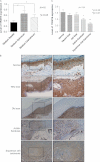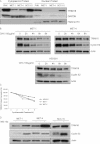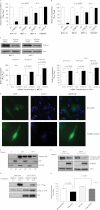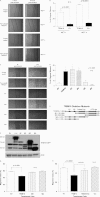The retinoid signalling molecule, TRIM16, is repressed during squamous cell carcinoma skin carcinogenesis in vivo and reduces skin cancer cell migration in vitro
- PMID: 22009481
- PMCID: PMC3504077
- DOI: 10.1002/path.2986
The retinoid signalling molecule, TRIM16, is repressed during squamous cell carcinoma skin carcinogenesis in vivo and reduces skin cancer cell migration in vitro
Abstract
Retinoid therapy is used for chemo-prevention in immuno-suppressed patients at high risk of developing skin cancer. The retinoid signalling molecule, tripartite motif protein 16 (TRIM16), is a regulator of keratinocyte differentiation and a tumour suppressor in retinoid-sensitive neuroblastoma. We sought to determine the role of TRIM16 in skin squamous cell carcinoma (SCC) pathogenesis. We have shown that TRIM16 expression was markedly reduced during the histological progression from normal skin to actinic keratosis and SCC. SCC cell lines exhibited lower cytoplasmic and nuclear TRIM16 expression compared with primary human keratinocyte (PHK) cells due to reduced TRIM16 protein stability. Overexpressed TRIM16 translocated to the nucleus, inducing growth arrest and cell differentiation. In SCC cells, TRIM16 bound to and down regulated nuclear E2F1, this is required for cell replication. Retinoid treatment increased nuclear TRIM16 expression in retinoid-sensitive PHK cells, but not in retinoid-resistant SCC cells. Overexpression of TRIM16 reduced SCC cell migration, which required the C-terminal RET finger protein (RFP)-like domain of TRIM16. The mesenchymal intermediate filament protein, vimentin, was directly bound and down-regulated by TRIM16 and was required for TRIM16-reduced cell migration. Taken together, our data suggest that loss of TRIM16 expression plays an important role in the development of cutaneous SCC and is a determinant of retinoid sensitivity.
Copyright © 2011 Pathological Society of Great Britain and Ireland. Published by John Wiley & Sons, Ltd.
Figures







Similar articles
-
TRIM16 acts as a tumour suppressor by inhibitory effects on cytoplasmic vimentin and nuclear E2F1 in neuroblastoma cells.Oncogene. 2010 Nov 18;29(46):6172-83. doi: 10.1038/onc.2010.340. Epub 2010 Aug 23. Oncogene. 2010. PMID: 20729920 Free PMC article.
-
TRIM16 inhibits proliferation and migration through regulation of interferon beta 1 in melanoma cells.Oncotarget. 2014 Oct 30;5(20):10127-39. doi: 10.18632/oncotarget.2466. Oncotarget. 2014. PMID: 25333256 Free PMC article.
-
Heterozygous loss of keratinocyte TRIM16 expression increases melanocytic cell lesions and lymph node metastasis.J Cancer Res Clin Oncol. 2019 Sep;145(9):2241-2250. doi: 10.1007/s00432-019-02981-5. Epub 2019 Jul 24. J Cancer Res Clin Oncol. 2019. PMID: 31342168 Free PMC article.
-
Suppression of squamous cell carcinoma growth and differentiation by retinoids.Cancer Res. 1994 Apr 1;54(7 Suppl):1987s-1990s. Cancer Res. 1994. PMID: 8137325 Review.
-
Molecular Mechanisms of p63-Mediated Squamous Cancer Pathogenesis.Int J Mol Sci. 2019 Jul 23;20(14):3590. doi: 10.3390/ijms20143590. Int J Mol Sci. 2019. PMID: 31340447 Free PMC article. Review.
Cited by
-
TRIM16 inhibits neuroblastoma cell proliferation through cell cycle regulation and dynamic nuclear localization.Cell Cycle. 2013 Mar 15;12(6):889-98. doi: 10.4161/cc.23825. Epub 2013 Feb 19. Cell Cycle. 2013. PMID: 23422002 Free PMC article.
-
TRIM16 suppresses the progression of prostate tumors by inhibiting the Snail signaling pathway.Int J Mol Med. 2016 Dec;38(6):1734-1742. doi: 10.3892/ijmm.2016.2774. Epub 2016 Oct 17. Int J Mol Med. 2016. Retraction in: Int J Mol Med. 2023 Jul;52(1):59. doi: 10.3892/ijmm.2023.5262. PMID: 27748839 Free PMC article. Retracted.
-
A novel compound which sensitizes BRAF wild-type melanoma cells to vemurafenib in a TRIM16-dependent manner.Oncotarget. 2016 Aug 9;7(32):52166-52178. doi: 10.18632/oncotarget.10700. Oncotarget. 2016. PMID: 27447557 Free PMC article.
-
Withaferin A activates TRIM16 for its anti-cancer activity in melanoma.Sci Rep. 2020 Nov 12;10(1):19724. doi: 10.1038/s41598-020-76722-x. Sci Rep. 2020. PMID: 33184347 Free PMC article.
-
TRIM16 overexpression induces apoptosis through activation of caspase-2 in cancer cells.Apoptosis. 2013 May;18(5):639-51. doi: 10.1007/s10495-013-0813-y. Apoptosis. 2013. PMID: 23404198 Free PMC article.
References
-
- Armstrong BK, Kricker A. The epidemiology of UV induced skin cancer. J Photochem Photobiol B. 2001;63:8–18. - PubMed
-
- Halliday GM, Norval M, Byrne SN, et al. The effects of sunlight on the skin. Drug Discov Today: Disease Mechanisms. 2008;5:e201–e209.
-
- Lotan R, Xu XC, Lippman SM, et al. Suppression of retinoic acid receptor-beta in premalignant oral lesions and its up-regulation by isotretinoin. N Engl J Med. 1995;332:1405–1410. - PubMed
-
- Cheung B, Hocker JE, Smith SA, et al. Retinoic acid receptors beta and gamma distinguish retinoid signals for growth inhibition and neuritogenesis in human neuroblastoma cells. Biochem Biophys Res Commun. 1996;229:349–354. - PubMed
Publication types
MeSH terms
Substances
Grants and funding
LinkOut - more resources
Full Text Sources
Medical
Molecular Biology Databases
Research Materials

